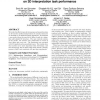Free Online Productivity Tools
i2Speak
i2Symbol
i2OCR
iTex2Img
iWeb2Print
iWeb2Shot
i2Type
iPdf2Split
iPdf2Merge
i2Bopomofo
i2Arabic
i2Style
i2Image
i2PDF
iLatex2Rtf
Sci2ools
95
Voted
AVI
2010
2010
The effect of stereoscopy and motion cues on 3D interpretation task performance
We study the effectiveness of stereoscopy and smooth motion as 3D cues for medical interpretation of vascular structures as obtained by 3D medical imaging techniques. We designed a user study where the user has to follow a path in a mazelike solid shaded 3D structure. The user controls rotation of the model. We measure user performance in terms of time taken and error rate. The experiment was executed with 32 (medical and non-medical) users. The results show that motion cue is more important than stereoscopy, and that stereoscopy has no added value when motion is already present, which is not consistent with previous experiments. Categories and Subject Descriptors H.5.2 [Information Interfaces and Presentation]: User interfaces--Evaluation/methodology; I.3.7 [Computer Graphics]: Three-dimensional Graphics and Realism General Terms Graphics, Human Factors Keywords motion cue, stereoscopy, medical visualization, angiography
AVI 2010 | Motion Cue | Software Engineering | Stereoscopy | User |
| Added | 29 Oct 2010 |
| Updated | 29 Oct 2010 |
| Type | Conference |
| Year | 2010 |
| Where | AVI |
| Authors | Boris W. van Schooten, Elisabeth M. A. G. van Dijk, Elena V. Zudilova-Seinstra, Avan Suinesiaputra, Johan H. C. Reiber |
Comments (0)

